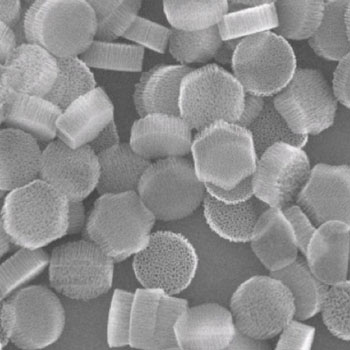“Nanoconstructs” Designed to Enhance MRI Technology
By MedImaging International staff writers
Posted on 01 Jul 2014
Submicrometer particles that contain even smaller particles of iron oxide could make magnetic resonance imaging (MRI) a much more effective way to detect and fight disease. Posted on 01 Jul 2014
Medical researchers are creating composite particles that can be injected into patients and guided by magnetic fields. Once in position, the particles may be heated to kill malignant tissues or trigger the release of drugs at the site. The nanoscale composites, called “nanoconstructs,” should completely degrade and leave the body within a couple of days, the researchers reported.

Image: Silicon mesoporous particles (SiMPS), measure about 1,000 nm across contain thousands of much smaller particles of iron oxide. The SiMPs can be manipulated by magnets and gather at the site of tumors, where they can be heated to kill malignant tumors or trigger the release of drugs. The particles were created by an international team led by scientists at Rice University and Methodist Hospital Research Institute (Houston, TX, USA) (Photo courtesy of Rice University).
The research, conducted by scientists from Rice University (Houston, TX, USA) and the Methodist Hospital Research Institute (TMHRI; Houston, TX, USA), led an international team of researchers and published their findings online April 22, 2014, in the journal Advanced Functional Materials. The team, led by Rice chemist Lon Wilson and TMHRI scientist Paolo Decuzzi, was searching for a way to overcome the challenges presented by iron oxide particles that are good at some things but not others, depending on their size. Iron oxide particles have many excellent features: They can be manipulated with magnets, provide excellent contrast under MRI scanning, generate heat when triggered, and degrade rapidly; however, they cannot do all that at once. The scientists needed a way to decouple the functions from their sizes.
The answer to the problem was to parcel thousands of iron oxide particles—with magnetic cores as small as 5 nm across—inside larger particles. The researchers created two such nanoconstructs, embedding iron oxide particles in silicon mesoporous particles (SiMPs) and discoidal polymeric nanoconstructs (DPNs). They knew from earlier research that submicron-sized SiMPs and DPNs naturally accumulate within the tumor’s blood vessels.
Iron oxide enhances the ability to position and hold the particles in place with magnets, according to lead author and Rice graduate student Ayrat Gizzatov. “They get attracted by the magnet, and that induces another dipole-dipole magnetic interaction among the particles and increases their interparticle communication mechanism,” he said.
Tests showed iron oxide particles made the nanoconstructs 10 times better than traditional contrast agents with what amounted to significantly lower doses of iron than used in current practice. The new research also showed that, as a general principle, confining MRI contrast agents (i.e., iron oxide) in geometric structures enhances their relaxivity—the feature that makes the agents appear in MRI images. (The shorter the relaxation time, the greater the contrast in the image.)
While the particles are too big to target specific proteins, Mr. Gizzatov noted that it might also be possible to engineer them with elements that will increase their accumulation in tumors.
Related Links:
Rice University
Methodist Hospital Research Institute














